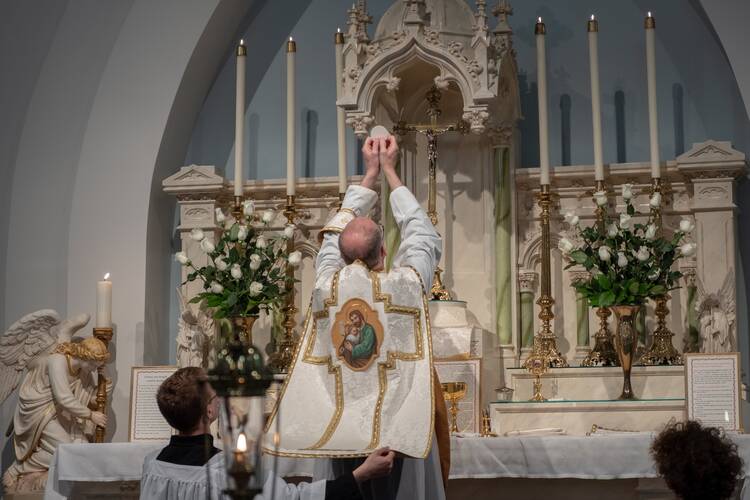Every so often the secular press rediscovers the Tridentine Mass, often called the Latin Mass, and offers an analysis of its place in the church. The latest reporting is a piece in The New York Times by Ruth Graham which highlights the liturgy’s popularity in the United States in the face of Pope Francis’ efforts to limit its use.
I do not have strong feelings about the Latin Mass one way or another. But I do have some strong feelings about the way enthusiasm for it is too often framed. In my experience, many Latin Mass enthusiasts cite the “reverence” of the Latin Mass as a pull factor, which is fine and understandable in itself. But these comments frequently come within the context of a comparison. Frequently the implication, sometimes explicit sometimes not, is that the Mass in the vernacular that emerged after the Second Vatican Council is lacking this same reverence. Ms. Graham confirms this trend in her piece:
[A]lmost all Latin Mass devotees use a version of the word “reverent” unprompted, contrasting the tone of the Latin Mass with oft-cited if rare examples in modern parishes featuring nontraditional elements like puppets and balloons, a casual treatment of the Eucharist, or music and dance they consider disrespectful. (Emphasis mine)
In this context, it seems the value of the Latin Mass comes in large part from the ways in which it is more reverent than other forms of the Mass. Such framing also frequently creates a false equivalency between a standard Sunday Mass and what Graham acknowledged are “oft-cited if rare” examples of potential liturgical abuses outside the church’s norms. The Latin Mass may help many people feel closer to God, but whatever reverence it inspires need not be framed in relation to other styles of worship. The vast majority of Catholics are not facing a decision between Latin Mass or a puppet Mass each Sunday.
The way we talk about the liturgy matters, and to describe something as “irreverent” assumes a level of malicious intent on the part of worshipers that other terms do not.
The way we talk about the liturgy matters, and to describe something as “irreverent” assumes a level of malicious intent on the part of worshipers that other terms do not. The word reverence means deep respect. Reverence is much more closely related to intentionality than to a particular ritual; it has more to do with one’s attitude than one’s attire. It also is deeply intertwined with how a particular ritual or liturgy inspires us to treat others, especially others whose preferences or values are different from our own.
Some forms of liturgy certainly are more solemn, somber or serious in tone, and the church tells us as much in “Sacrosanctum Concilium”:
Therefore sacred music is to be considered the more holy in proportion as it is more closely connected with the liturgical action, whether it adds delight to prayer, fosters unity of minds, or confers greater solemnity upon the sacred rites. But the Church approves of all forms of true art having the needed qualities, and admits them into divine worship.
A reverent liturgy should be within the guidelines the church offers, and it should encourage those in attendance to participate humbly, intentionally, respectfully and with gratitude as they strive to move closer to God. Too often, the descriptions of the Latin Mass as “more reverent” cite liturgical attributes that are inspired by European aesthetics and the sensibilities of overwhelmingly white congregations. By default, labeling the Latin Mass as “more” reverent—rather than one source of reverence for an individual Catholic or a group of us—diminishes the real sense of reverence present in our global church.
The deep respect that reverence requires can be displayed in many ways. And it should be displayed in its diversity if we are to live out the universal nature of Catholicism. A community singing and clapping to hymns in Rwanda or Catholics in the Gospel choir praising God in a Mass in Harlem or suburban Catholics belting out a St. Louis Jesuits song are not inherently “less”—or more—reverent than Catholics attending the Latin Mass.
The church acknowledges Gregorian chant as “specially suited” for liturgy but does not exclude guitars from possibly “adding delight to prayer.” There is nothing inherently more reverent about a chapel veil than an African head wrap. Lace garments are not inherently more reverent than felt banners. Various elements of the liturgy might be more formal or more solemn, but we need to stop using the word “reverent” as a stand-in for these other qualities.
And any type of worship, no matter the style, can be irreverent if done with the wrong intention
The Mass should be a place of unity that allows us to notice beauty everywhere, not a battlefield or a competition. No matter what you think of particular types of church decor or liturgical style, it is hard not to see the real reverence present in a spirit-inspired child carefully and proudly hanging their colorful first Communion banner on a pew or dressed in a lace-adorned altar server alb and swinging a thurible.
The Latin Mass might feel more reverent to some worshippers, and that is fine and legitimate. But maybe the mariachi Mass feels more reverent to others. Joyful, lively music is not inherently irreverent. Reverence is not measured by volume or tempo or style. Is your favorite liturgy style within church norms and done intentionally and with respect for the Eucharist, for God and for others? Then it is reverent.
And any type of worship, no matter the style, can be irreverent if done with the wrong intention. For example: Using the liturgy as a prop for promoting one’s political beliefs or desires. Treating it as a cudgel to beat other Catholics into agreement or punish those with differing opinions. Catholics of all stripes do this, but there is a particularly egregious example of this type of needless division in Ms. Graham’s article: “The Latin Mass ‘brings the true Catholics out,’” Kristin Kopy, 41, whose husband works for Church Militant, told Ms. Graham.
I don’t think that Ms. Kopy’s opinion is representative of all Latin Mass-goers, or even most of them. But it is not hard to argue that a view of Mass that is inspired by judgment of others is not reverent. And all of us can stand to be reminded at times: What brings out the “real” Catholics is our baptism, and our good-faith efforts to live out that baptismal call to be priest, prophet and king. And to do this with joy and, yes, reverence for the God who sees and reveres us all.








